Intelligence Briefing - Violence in Ecuador
By Nikhita Nainwal
Summary
On 7 January 2024, one of the most powerful drug lords in Ecuador, Adolfo “Fito” Macías, escaped from prison, triggering a wave of gang violence in prisons and on the streets. Responding to this violence, President Noboa declared a nationwide state of emergency lasting 60 days on 9 January. The armed forces have been granted “all the political and legal support” they need to “neutralise” the criminal groups.
Recent Developments
On 7 January, high-profile gang leader Adolfo “Fito” Macías escaped from prison, hours before he was to be transferred to La Roca, a maximum-security facility in Guayaquil. The next day, riots took place in at least six jails nationwide and another gang leader, Fabricio Colón Pico, who was also set to be transferred to La Roca, escaped from prison.
On 8 January, President Noboa declared “a state of internal armed conflict” under which, the laws of war can be applied to organised criminals as if they were terrorists or insurgents. 22 gangs have been classified as “terrorist organisations” and a curfew from 11pm to 5am has been set. Over 22,000 soldiers have been deployed to implement these measures. Additionally, foreigners who want to enter the country from Colombia or Peru will have to provide a criminal record certificate.
On 11 January, Pico released a public statement saying he ran away because he was scared of being killed in custody and would turn himself in if his safety could be guaranteed, which was turned down by Noboa. The whereabouts of Fito remain unknown.
On 11 January, the U.S. State Department released a statement saying that American law enforcement, military and government officials would visit Ecuador to assist in its fight against what the department called “appalling levels of violence and terrorism at the hands of narco-criminal elements.”
Between 7 January and 13 January, several acts of violence took place nationwide- around 180 prison staff were taken hostage, armed men took over IESS hospital in Machala and the University of Guayaquil, police officers were kidnapped, vehicles were set on fire, explosives were detonated, and a TV station was attacked. [Graphic content: violence].
Map of the incidents from 7 to 13 of January
Locations of the incidents and their nature
Penitenciaria de Latacunga → Prison staff taken hostage
Deprivation of Liberty Center Regional Guayas → Adolfo “Fito” Macías escaped from here.
Centro De Detención Provisional - Riobamba → Fabricio Colon Pico escaped with 37 other inmates.
Centro De Rehabilitación Social Santo Domingo de Los Tsáchilas → 3 prisoners escaped.
Cárcel Provisional de Esmeraldas → a group of inmates shot at the Armed Forces personnel who were outside the prison.
Centro De Rehabilitación Social "CRS-TURI" → Prison riots
Social Rehabilitation Center - Jail Loja → Prison riots
Centro de Detencion Provisional - Quito → Prison riots
Hospital IESS de Machala → Takeover by armed men
University of Guayaquil (UG) → Takeover by armed men
UPC de Policía Wilson Franco → Three police officers kidnapped
UPC Llano Grande→ One police officer kidnapped
Gasolinera Primax, Vuelta Larga → Explosives thrown on vehicles.
Tonsupa → Vehicle set on fire.
Esmeraldas Police Headquarters → Explosives thrown here.
TC Televisión → Was under siege for a few hours.
Centro De Rehabilitacion Social Machala CRS → Prison riots
Screenshot of a X (former Twitter) video featuring police officials allegedly being kidnapped and threatened by a carter
Since then, over 1000 people have been arrested for such gang-related crimes, including some leaders of gangs and government employees.
By 15 January, the armed forces reportedly took control over several prisons and freed more than 200 officials held in these prisons.
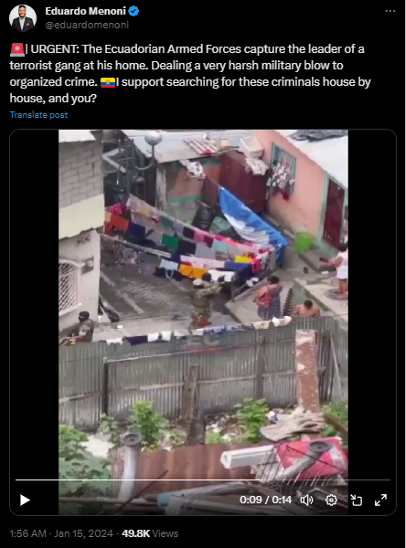
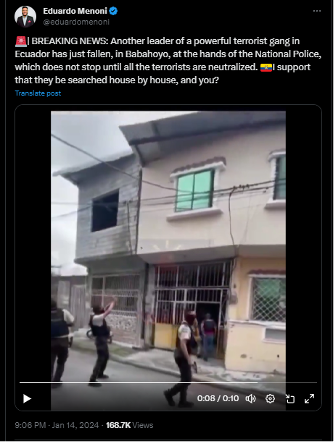
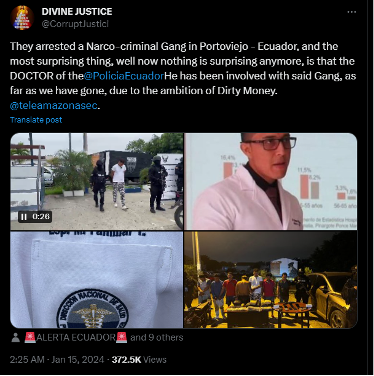
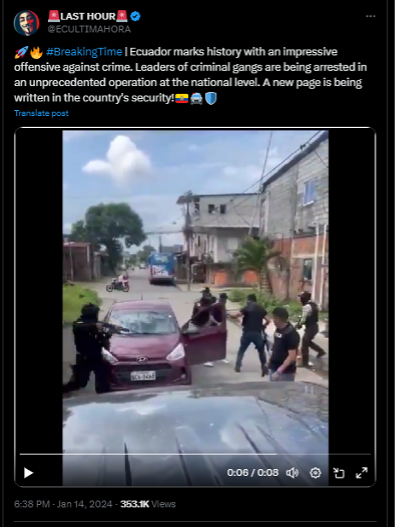
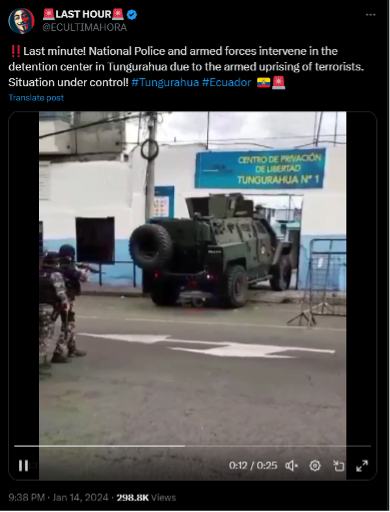
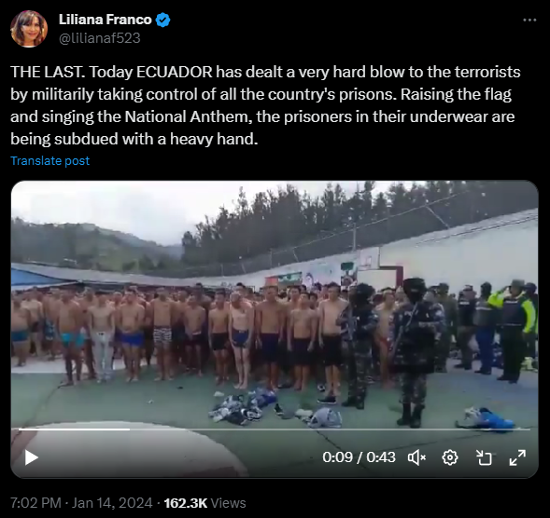
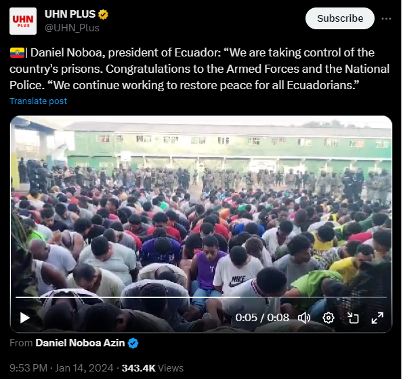
Analysis
Ecuador is not a drug producer. Rather, its strategic location flanked by Colombia and Peru, the top two producers of cocaine, makes it a crucial transit point for drug trafficking. Its deep ports, particularly in Guayaquil on the Pacific coast, provide convenient routes for smuggling cocaine to North America, Europe, and Asia. Until the mid-2010s, the drug trafficking routes in Ecuador were controlled by a guerrilla army, the Revolutionary Armed Forces of Colombia (FARC). During this time, Ecuador was a relatively peaceful country compared to the other countries in this region. The disbandment of the FARC in 2016 opened up these routes for others. Foreign gangs rushed to fill this void, and local gangs started siding with these foreign actors. For example, it is speculated that the Los Lobos are affiliated with the Jalisco New Generation Cartel, while the Los Choneros are affiliated with the Sinaloa Cartel, two of the biggest Mexican crime organisations. Thus, there is a high possibility that the sharp rise in Ecuador’s violence is related to this power struggle between the different gangs.
Source: Ecuador Project (2019), Insidecrime.org
It is almost certain that government officials and national institutions play a role in facilitating drug trafficking and gang activity in Ecuador. The fact that both Fito and Pico escaped prison hours before their transfers to La Roca, despite the transfer plan not being public knowledge, indicates that they might have received their information from a government leak. This is backed by the conclusions of “Caso Metastasis”, a drug trafficking investigation launched by Attorney General Diana Salazar in December 2023, which led to raids across Ecuador and more than 30 arrests. These arrests included several government officials, including Wilman Terán, the President of the Judicial Council, and Pablo Ramírez, the former head of the country’s prison system.
Prisons have been the main theatre of violence in the country. Since 2021, prison riots have claimed the lives of more than 400 inmates. This is because prisons often serve as headquarters for the criminal organisations. Gang leaders, even when incarcerated, can use prisons as a central hub for managing their criminal enterprises, especially if they have the cooperation of the authorities. It is highly probable that Fito and Pico escaped prison only after finding out about their transfer as La Roca is a maximum security facility, which might have made it harder for them to operate their criminal rings.
President Noboa’s iron-fisted strategy to control violence is most likely inspired by the approach taken by President Nayib Bukele in El Salvador. El Salvador, which once like Ecuador, was plagued by extreme gang violence, is now perceived as one of the safest places in Latin America. This success is attributed to Bukele’s militarization of the country and mass arrests of suspected gang members, often without due process. President Noboa’s declaration of emergency as well as the deployment of over 22,000 security forces mirrors this approach. Furthermore, he has announced the construction of two maximum security jails, to be built by international groups that built the prisons in El Salvador.
Conclusion
Reducing crime and violence will continue to be the top priority for President Noboa, who won his elections, held in October 2023, centred around the same agenda. His recent decisions and statements show that he will be taking a much harsher stance against drug usage and drug trafficking in the country as compared to his predecessors. It is likely that he will be successful in reducing violence in Ecuador in the short term, but the long-term success of his measures will depend on whether he is able to eliminate the rampant corruption in the national institutions, and whether he is able to control the influence of powerful foreign criminal organisations on the local criminal groups.



